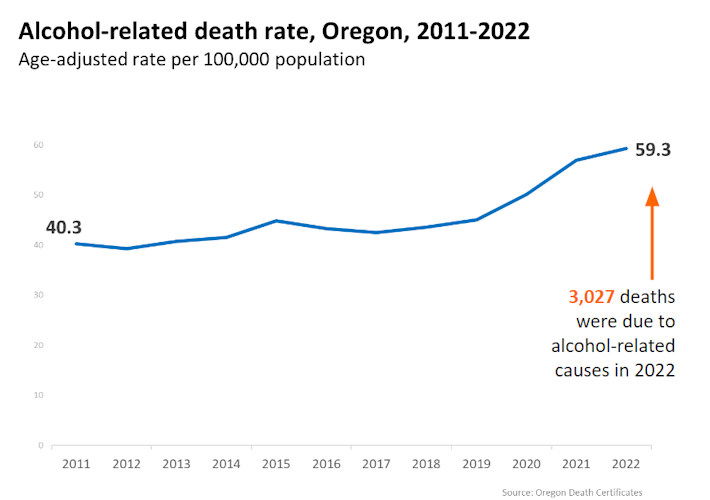Oregon alcohol-related deaths jump 30% in three years; Oregon Recovers urges state leaders take ‘swift, definitive action’

PORTLAND, Ore. (KTVZ) --The Oregon Health Authority has released new data revealing that eight Oregonians die each day due to alcohol, a dramatic 30% leap over just three years.
According to Dr. Dean E. Sidelinger, Oregon's State Epidemiologist, 3,027 individuals died alcohol-related deaths in 2022. He shared the new data at the Oregon Recovers Alcohol Policy Summit last week in Portland. Among his top recommendations for reversing this trend are to raise the price of alcohol and to limit its accessibility.
“It’s clear—once again—that Oregon has an alcohol problem. It's time for policymakers and OLCC commissioners to start listening to our state epidemiologist and stop listening to lobbyists for the alcohol industry,” said Mike Marshall, executive director of Oregon Recovers.
“The people dying are our friends and neighbors, and all of their deaths were avoidable. Alcohol use in Oregon has become a serious public health crisis that our state leaders need to start taking seriously. Oregon Recovers calls on Governor Kotek and the Legislature to take swift, definitive action to reduce the number of alcohol-related deaths in Oregon.”
Alcohol Quick Facts
- Alcohol is a toxic, addictive carcinogen that kills more Oregonians than all other drugs combined.
- Alcohol use is Oregon’s third-leading cause of preventable death.
- Of substance use-related hospitalizations nationally, 42% are related to alcohol. (Opioids 15%, methamphetamine 11%, marijuana 11%, and cocaine 5%.)
- Oregon ranks 5th nationally in alcohol addiction; 12% of Oregonians have alcohol use disorder.
- Oregon ranks 50th in access to addiction treatment, with 18% of Oregonians needing but not receiving treatment.
- Each alcoholic drink sold in Oregon costs local and state governments $2.08 in lost workplace productivity, health care expenses, criminal justice costs, and motor vehicle crashes.
- The total economic costs of excessive drinking in Oregon were $4.8 billion in 2019.
Oregon currently has the lowest beer tax and the second-lowest wine tax in the country, when factoring in the lack of a state sales tax. Beer taxes are less than 1 cent per bottle, and haven’t been raised since 1977. Wine taxes are 3 cents a glass, and haven’t been raised since 1982.
An increase in alcohol pricing is a proven public health tool recommended by the CDC to reduce harmful consumption, just like with tobacco. It works: in Maryland, a 3 percentage point price increase led to a 26% decline in underage drinking and 17% decline in binge drinking.
Raising alcohol prices to reduce harmful consumption and fund services is popular with voters. Six in 10 Oregonians support increasing alcohol taxes in order to reduce harmful alcohol use like binge drinking and underage drinking. And 76% support increasing alcohol taxes to fund expanded access to drug and alcohol addiction treatment and recovery support services.
Out-of-state alcohol mega-corporations use predatory marketing strategies—targeting low-income people and people of color—to foster alcohol addiction. They depend on creating excessive drinkers to make profits: 10% of American drinkers (24 million adults over age 18) consume nearly 60% of all alcohol sold, an average of 10 drinks a day.
Oregon Recovers has put forward an Emergency 12 Step Plan to End Oregon’s Addiction Crisis. The goals of the plan are to: 1) reduce fatal drug overdoses by 50% within one year. 2) Reduce alcohol-related deaths by 50% within one year. And 3) Eliminate wait lists for detox, residential treatment & recovery housing within six months. Alcohol-related steps include:
Step One: Execute A Coordinated Response to the Addiction Crisis:
- Declare that the addiction crisis has become a state emergency, requiring an emergency response.
- Consolidate Alcohol & Drug Policy Commission (ADPC), M110 Oversight & Accountability Commission (OAC) and Opioid Settlement Committee into one decision making body led by the Executive Director of the ADPC, who reports directly to the Governor.
- Update and implement the state ADPC Strategic Plan to end the addiction crisis.
- Within 90 days require OLCC, OHA & ADPC to develop a joint plan to reduce excessive alcohol & cannabis consumption by 25% by January 2025.
Step Six: Prioritize Prevention First. Direct the ADPC to conduct a comprehensive assessment of statewide prevention programs and provide the legislature with draft legislation resulting in the design, implementation and funding of a comprehensive state prevention program which aligns with the SAMHSA definition of primary prevention.
Step Twelve: Increase Cannabis & Alcohol Prices. Reduce harmful consumption and costly demands on the health care system by increasing the price of all mind-altering substances:
- Increase state police prosecution of illegal cannabis operations
- Direct law enforcement to confiscate all levels of illegal substances
- Introduce Minimum Unit Pricing (MUP) for all cannabis products
- Increase current MUP for alcohol and expand to include beer, wine & cider
- Tax cannabis and alcohol at equal levels
Recovery Support
Help can be found on the Oregon Recovers website OregonRecoveryNetwork.org or by calling SAMHSA's National Helpline 1-800-662-HELP (4357).
About Oregon Recovers
Oregon Recovers is an inclusive statewide coalition of people in recovery–and their friends and family—uniting to transform Oregon healthcare to ensure world-class prevention, treatment, and recovery support services for Oregonians suffering from the disease of addiction.